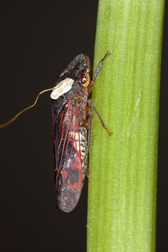Washington, DC, USA
June 7, 2012
 When an insect pierces the surface of a plant to feed, much of the action takes place in the plant's interior. A device called the Electrical Penetration Graph (EPG) is a critical tool for peering into the process.
When an insect pierces the surface of a plant to feed, much of the action takes place in the plant's interior. A device called the Electrical Penetration Graph (EPG) is a critical tool for peering into the process.
Now a new type of EPG developed by U. S. Department of Agriculture (USDA) entomologists is giving scientists the clearest view yet of the wars waged between piercing-sucking insects and the plants they attack.
The EPG was developed by Elaine Backus at the Agricultural Research Service (ARS) San Joaquin Valley Agricultural Sciences Center, in Parlier, Calif., and her late partner William Bennett from the University of Missouri.
ARS is USDA's principal intramural scientific research agency, and this research supports the USDA goal of promoting agricultural sustainability.
To use an EPG, researchers connect the insect and plant to an electronic monitor that reads electrical charges produced by changes in voltage that occur as the insect feeds. At least eight different systems have been developed, and researchers who study aphids and other piercing-sucking insects have used them over the years to publish nearly 400 peer-reviewed papers. But the new EPG is much more versatile than any of its predecessors, and is being used by researchers around the country in ways expected to broaden understanding of how plant-feeding insects cause so much damage.
Traditionally, monitors have been designed to work with either AC or DC current. Because of the physics that govern electricity and the flow of electrical current, researchers have been likely to get best results using AC monitors when studying larger insects and DC monitors when studying smaller insects.
Ideally, a monitor should be capable of studying a variety of insect sizes. As the name implies, the team's AC-DC Monitor incorporates design features from both AC and DC monitors, making it more versatile. Researchers can adjust the settings to the sizes of any insect they are studying. Entomologists will be able to view the feeding process in detail for more insects than ever before. They also will be better able to compare the feeding habits of pathogen-bearing insects with those that are pathogen-free.
Backus and Bennett described the AC-DC Monitor in a recent issue of the Journal of Insect Physiology.
Read more about this research in the May/June 2012 issue of Agricultural Research magazine.
Photo: A young adult glassy-winged sharpshooter wired up while it’s feeding on a plant is being recorded by an AC-DC EPG. Photo by Stephen Ausmus.
Una nueva herramienta para observar la guerra entre los insectos y las plantas
Cuando un insecto perfora la superficie de una planta para alimentarse, la mayoría de la acción ocurre dentro de la planta. Un aparato llamada 'Electrical Penetration Graph' (gráfico de penetración eléctrica, o EPG por sus siglas en inglés) es una herramienta imprescindible para observar este proceso.
Ahora un nuevo tipo de EPG desarrollado por entomólogos del Servicio de Investigación Agrícola (ARS) está proveyendo a los científicos la vista más clara hasta la fecha de la guerra entre las plantas y los insectos.
El EPG fue desarrollado por Elaine Backus en el Centro del Valle de San Joaquín para las Ciencias Agrícolas, ubicado en Parlier, California, y su colega difunto William Bennett de la Universidad de Misurí.
ARS es la agencia principal de investigaciones científicas del Departamento de Agricultura de EE.UU. (USDA por sus siglas en inglés), y esta investigación apoya la prioridad del USDA de promover la sostenibilidad de agricultura.
Para usar un EPG, los investigadores conectan el insecto y la planta a un monitor electrónico que indica las cargas eléctricas producidas por los cambios en voltaje que ocurren cuando el insecto se alimenta. Por lo menos ocho sistemas eléctricos han sido desarrollados para realizar estos estudios, y los investigadores que estudian los pulgones y otros insectos que perforan y chupan plantas han usado estos sistemas por muchos años, con sus resultados publicados en casi 400 artículos revisados por pares. Pero el nuevo EPG es más versátil comparado con los otros sistemas, y está siendo usado por investigadores en todas partes de EE.UU. en estudios que podrían aumentar los conocimientos sobre cómo estos insectos causan los daños significativos en las plantas.
Tradicionalmente, los monitores han sido diseñados para funcionar con la corriente alterna (CA, o AC por sus siglas en inglés) o la corriente directa (CD, o DC por sus siglas en inglés). A causa de la física que gobierna la electricidad y el flujo de corriente eléctrica, los investigadores han obtenido los mejores resultados utilizando los monitores que usan CA para estudios de insectos más grandes y los monitores que usan CD para estudios de insectos más pequeños.
Idealmente, el monitor debe tener la capacidad de estudiar una variedad de tamaños de insectos. Como indica el nombre, el Monitor AC-DC incluye aspectos de diseño de ambos tipos de monitores, de este modo aumentando su versatilidad. Los investigadores pueden cambiar los ajustes con relación al tamaño del insecto estudiado. Los entomólogos podrán observar en detalle el proceso de alimentación para una gama más amplia de insectos. También podrán comparar mejor los hábitos de alimentación de los insectos que propagan enfermedades así como aquellos que no las propagan.
Backus y Bennett describieron el Monitor AC-DC en un artículo en un número reciente de 'Journal of Insect Physiology' (Revista de la Fisiología de Insectos).
Lea más sobre esta investigación en la revista 'Agricultural Research' de mayo-junio del 2012.